Lifan Yuan
Probing the Critical Point (CritPt) of AI Reasoning: a Frontier Physics Research Benchmark
Oct 01, 2025Abstract:While large language models (LLMs) with reasoning capabilities are progressing rapidly on high-school math competitions and coding, can they reason effectively through complex, open-ended challenges found in frontier physics research? And crucially, what kinds of reasoning tasks do physicists want LLMs to assist with? To address these questions, we present the CritPt (Complex Research using Integrated Thinking - Physics Test, pronounced "critical point"), the first benchmark designed to test LLMs on unpublished, research-level reasoning tasks that broadly covers modern physics research areas, including condensed matter, quantum physics, atomic, molecular & optical physics, astrophysics, high energy physics, mathematical physics, statistical physics, nuclear physics, nonlinear dynamics, fluid dynamics and biophysics. CritPt consists of 71 composite research challenges designed to simulate full-scale research projects at the entry level, which are also decomposed to 190 simpler checkpoint tasks for more fine-grained insights. All problems are newly created by 50+ active physics researchers based on their own research. Every problem is hand-curated to admit a guess-resistant and machine-verifiable answer and is evaluated by an automated grading pipeline heavily customized for advanced physics-specific output formats. We find that while current state-of-the-art LLMs show early promise on isolated checkpoints, they remain far from being able to reliably solve full research-scale challenges: the best average accuracy among base models is only 4.0% , achieved by GPT-5 (high), moderately rising to around 10% when equipped with coding tools. Through the realistic yet standardized evaluation offered by CritPt, we highlight a large disconnect between current model capabilities and realistic physics research demands, offering a foundation to guide the development of scientifically grounded AI tools.
The Entropy Mechanism of Reinforcement Learning for Reasoning Language Models
May 28, 2025



Abstract:This paper aims to overcome a major obstacle in scaling RL for reasoning with LLMs, namely the collapse of policy entropy. Such phenomenon is consistently observed across vast RL runs without entropy intervention, where the policy entropy dropped sharply at the early training stage, this diminished exploratory ability is always accompanied with the saturation of policy performance. In practice, we establish a transformation equation R=-a*e^H+b between entropy H and downstream performance R. This empirical law strongly indicates that, the policy performance is traded from policy entropy, thus bottlenecked by its exhaustion, and the ceiling is fully predictable H=0, R=-a+b. Our finding necessitates entropy management for continuous exploration toward scaling compute for RL. To this end, we investigate entropy dynamics both theoretically and empirically. Our derivation highlights that, the change in policy entropy is driven by the covariance between action probability and the change in logits, which is proportional to its advantage when using Policy Gradient-like algorithms. Empirical study shows that, the values of covariance term and entropy differences matched exactly, supporting the theoretical conclusion. Moreover, the covariance term stays mostly positive throughout training, further explaining why policy entropy would decrease monotonically. Through understanding the mechanism behind entropy dynamics, we motivate to control entropy by restricting the update of high-covariance tokens. Specifically, we propose two simple yet effective techniques, namely Clip-Cov and KL-Cov, which clip and apply KL penalty to tokens with high covariances respectively. Experiments show that these methods encourage exploration, thus helping policy escape entropy collapse and achieve better downstream performance.
The Unreasonable Effectiveness of Entropy Minimization in LLM Reasoning
May 21, 2025
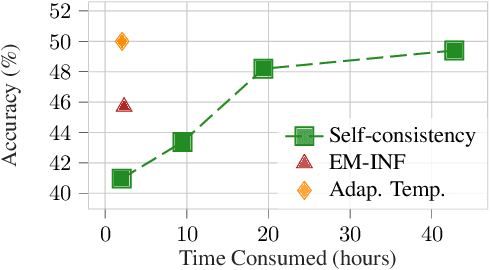
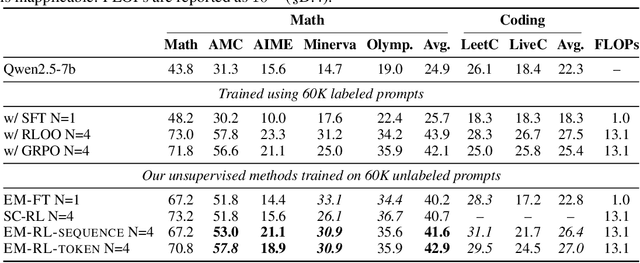
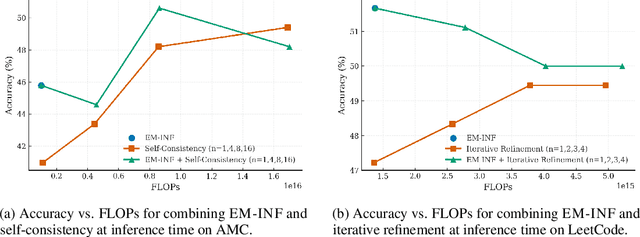
Abstract:Entropy minimization (EM) trains the model to concentrate even more probability mass on its most confident outputs. We show that this simple objective alone, without any labeled data, can substantially improve large language models' (LLMs) performance on challenging math, physics, and coding tasks. We explore three approaches: (1) EM-FT minimizes token-level entropy similarly to instruction finetuning, but on unlabeled outputs drawn from the model; (2) EM-RL: reinforcement learning with negative entropy as the only reward to maximize; (3) EM-INF: inference-time logit adjustment to reduce entropy without any training data or parameter updates. On Qwen-7B, EM-RL, without any labeled data, achieves comparable or better performance than strong RL baselines such as GRPO and RLOO that are trained on 60K labeled examples. Furthermore, EM-INF enables Qwen-32B to match or exceed the performance of proprietary models like GPT-4o, Claude 3 Opus, and Gemini 1.5 Pro on the challenging SciCode benchmark, while being 3x more efficient than self-consistency and sequential refinement. Our findings reveal that many pretrained LLMs possess previously underappreciated reasoning capabilities that can be effectively elicited through entropy minimization alone, without any labeled data or even any parameter updates.
Reinforcement Learning Finetunes Small Subnetworks in Large Language Models
May 16, 2025Abstract:Reinforcement learning (RL) yields substantial improvements in large language models (LLMs) downstream task performance and alignment with human values. Surprisingly, such large gains result from updating only a small subnetwork comprising just 5 percent to 30 percent of the parameters, with the rest effectively unchanged. We refer to this phenomenon as parameter update sparsity induced by RL. It is observed across all 7 widely used RL algorithms (e.g., PPO, GRPO, DPO) and all 10 LLMs from different families in our experiments. This sparsity is intrinsic and occurs without any explicit sparsity promoting regularizations or architectural constraints. Finetuning the subnetwork alone recovers the test accuracy, and, remarkably, produces a model nearly identical to the one obtained via full finetuning. The subnetworks from different random seeds, training data, and even RL algorithms show substantially greater overlap than expected by chance. Our analysis suggests that this sparsity is not due to updating only a subset of layers, instead, nearly all parameter matrices receive similarly sparse updates. Moreover, the updates to almost all parameter matrices are nearly full-rank, suggesting RL updates a small subset of parameters that nevertheless span almost the full subspaces that the parameter matrices can represent. We conjecture that the this update sparsity can be primarily attributed to training on data that is near the policy distribution, techniques that encourage the policy to remain close to the pretrained model, such as the KL regularization and gradient clipping, have limited impact.
Process Reinforcement through Implicit Rewards
Feb 03, 2025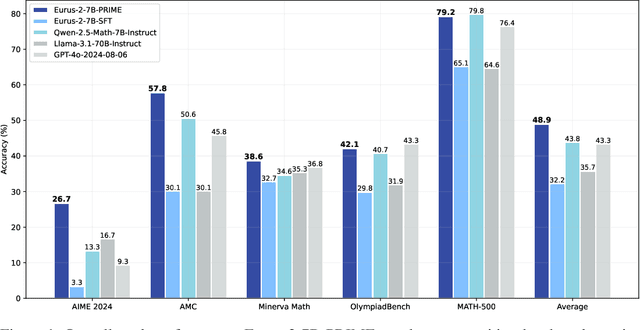

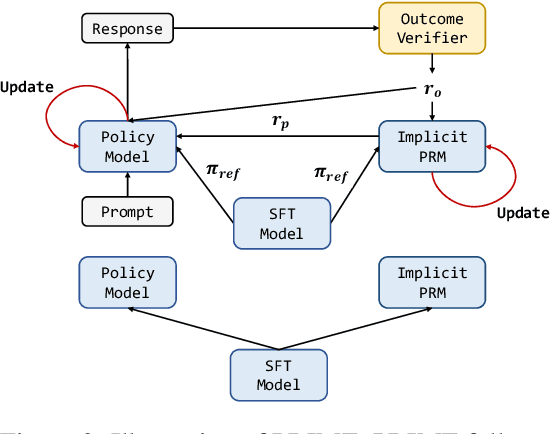
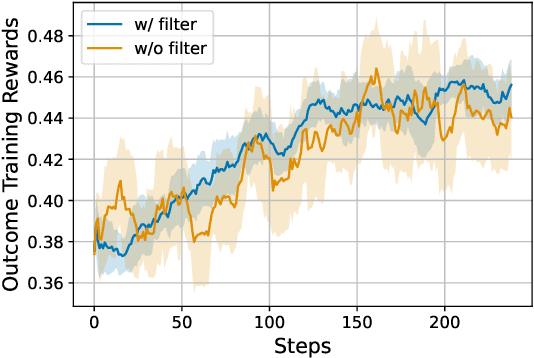
Abstract:Dense process rewards have proven a more effective alternative to the sparse outcome-level rewards in the inference-time scaling of large language models (LLMs), particularly in tasks requiring complex multi-step reasoning. While dense rewards also offer an appealing choice for the reinforcement learning (RL) of LLMs since their fine-grained rewards have the potential to address some inherent issues of outcome rewards, such as training efficiency and credit assignment, this potential remains largely unrealized. This can be primarily attributed to the challenges of training process reward models (PRMs) online, where collecting high-quality process labels is prohibitively expensive, making them particularly vulnerable to reward hacking. To address these challenges, we propose PRIME (Process Reinforcement through IMplicit rEwards), which enables online PRM updates using only policy rollouts and outcome labels through implict process rewards. PRIME combines well with various advantage functions and forgoes the dedicated reward model training phrase that existing approaches require, substantially reducing the development overhead. We demonstrate PRIME's effectiveness on competitional math and coding. Starting from Qwen2.5-Math-7B-Base, PRIME achieves a 15.1% average improvement across several key reasoning benchmarks over the SFT model. Notably, our resulting model, Eurus-2-7B-PRIME, surpasses Qwen2.5-Math-7B-Instruct on seven reasoning benchmarks with 10% of its training data.
Free Process Rewards without Process Labels
Dec 02, 2024



Abstract:Different from its counterpart outcome reward models (ORMs), which evaluate the entire responses, a process reward model (PRM) scores a reasoning trajectory step by step, providing denser and more fine grained rewards. However, training a PRM requires labels annotated at every intermediate step, presenting significant challenges for both manual and automatic data collection. This paper aims to address this challenge. Both theoretically and empirically, we show that an \textit{implicit PRM} can be obtained at no additional cost, by simply training an ORM on the cheaper response-level labels. The only assumption is to parameterize the outcome reward as the log-likelihood ratios of the policy and reference models, which can be optimized regardless of the specific choice of loss objectives. In experiments, we instantiate our implicit PRMs with various objectives and evaluate their performance on MATH. We show that our implicit PRM outperforms a strong MCTS-based baseline \textit{\'a la} Math-Shepherd using less than $1/38$ of the training data. Its performance can be further improved with majority voting. We further find that scaling up instructions and responses benefits our implicit PRM, and the latter brings a larger gain. Particularly, we find that our implicit PRM, when instantiated with the cross-entropy (CE) loss, is more data-efficient and can keep improving generation models even when trained with only one response per instruction, the setup that suffers from extreme data scarcity and imbalance. Further, instructions should be relevant to downstream tasks while the diversity of responses does not bring gains. Surprisingly, training on extra Math-Shepherd step labels brings no further improvements to our implicit PRM trained on only outcome data. We hope that our work will encourage a rethinking of PRM training approaches and contribute to making training PRMs more accessible.
Zero-Shot Generalization during Instruction Tuning: Insights from Similarity and Granularity
Jun 17, 2024



Abstract:Understanding alignment techniques begins with comprehending zero-shot generalization brought by instruction tuning, but little of the mechanism has been understood. Existing work has largely been confined to the task level, without considering that tasks are artificially defined and, to LLMs, merely consist of tokens and representations. This line of research has been limited to examining transfer between tasks from a task-pair perspective, with few studies focusing on understanding zero-shot generalization from the perspective of the data itself. To bridge this gap, we first demonstrate through multiple metrics that zero-shot generalization during instruction tuning happens very early. Next, we investigate the facilitation of zero-shot generalization from both data similarity and granularity perspectives, confirming that encountering highly similar and fine-grained training data earlier during instruction tuning, without the constraints of defined "tasks", enables better generalization. Finally, we propose a more grounded training data arrangement method, Test-centric Multi-turn Arrangement, and show its effectiveness in promoting continual learning and further loss reduction. For the first time, we show that zero-shot generalization during instruction tuning is a form of similarity-based generalization between training and test data at the instance level. We hope our analysis will advance the understanding of zero-shot generalization during instruction tuning and contribute to the development of more aligned LLMs. Our code is released at https://github.com/HBX-hbx/dynamics_of_zero-shot_generalization.
Advancing LLM Reasoning Generalists with Preference Trees
Apr 02, 2024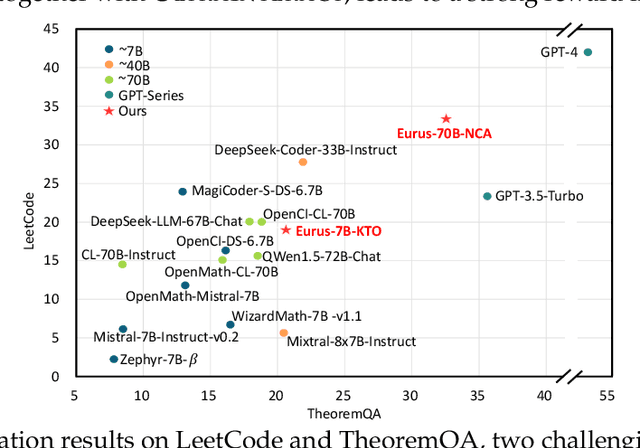

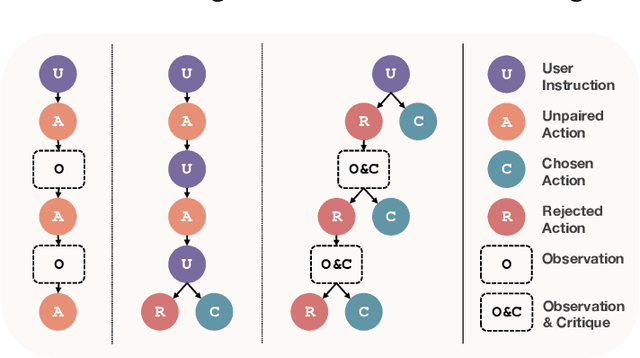
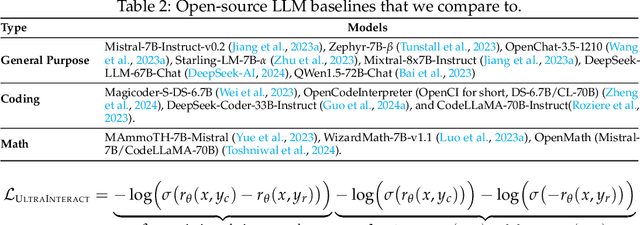
Abstract:We introduce Eurus, a suite of large language models (LLMs) optimized for reasoning. Finetuned from Mistral-7B and CodeLlama-70B, Eurus models achieve state-of-the-art results among open-source models on a diverse set of benchmarks covering mathematics, code generation, and logical reasoning problems. Notably, Eurus-70B beats GPT-3.5 Turbo in reasoning through a comprehensive benchmarking across 12 tests covering five tasks, and achieves a 33.3% pass@1 accuracy on LeetCode and 32.6% on TheoremQA, two challenging benchmarks, substantially outperforming existing open-source models by margins more than 13.3%. The strong performance of Eurus can be primarily attributed to UltraInteract, our newly-curated large-scale, high-quality alignment dataset specifically designed for complex reasoning tasks. UltraInteract can be used in both supervised fine-tuning and preference learning. For each instruction, it includes a preference tree consisting of (1) reasoning chains with diverse planning strategies in a unified format, (2) multi-turn interaction trajectories with the environment and the critique, and (3) pairwise data to facilitate preference learning. UltraInteract allows us to conduct an in-depth exploration of preference learning for reasoning tasks. Our investigation reveals that some well-established preference learning algorithms may be less suitable for reasoning tasks compared to their effectiveness in general conversations. Inspired by this, we derive a novel reward modeling objective which, together with UltraInteract, leads to a strong reward model.
Controllable Preference Optimization: Toward Controllable Multi-Objective Alignment
Feb 29, 2024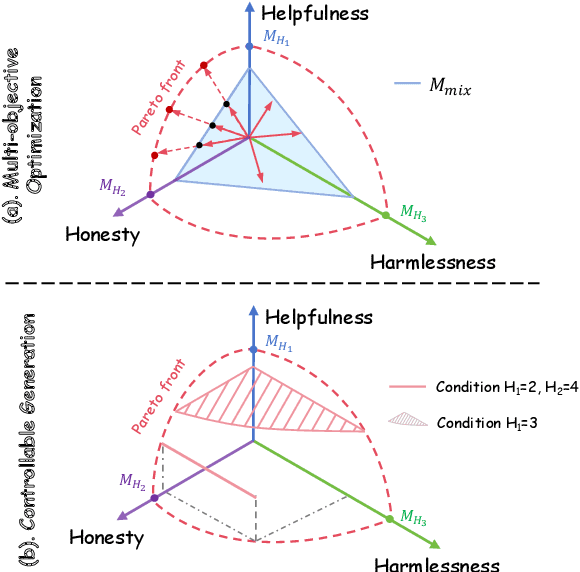
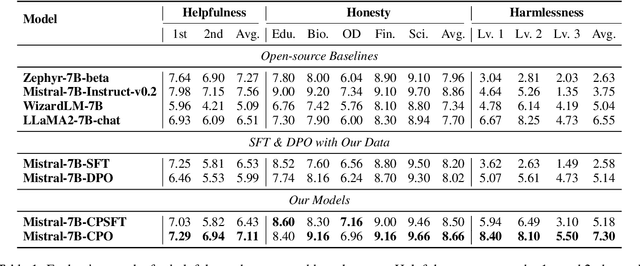
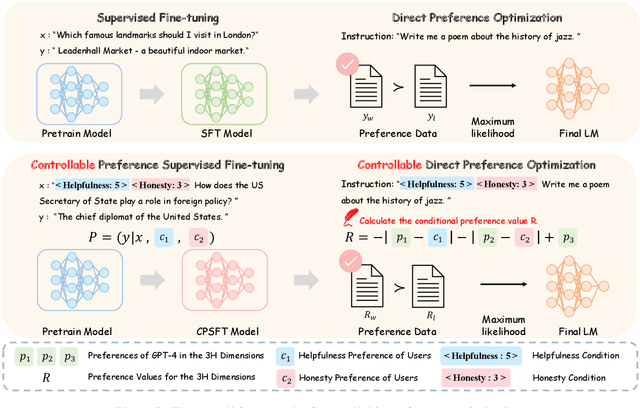
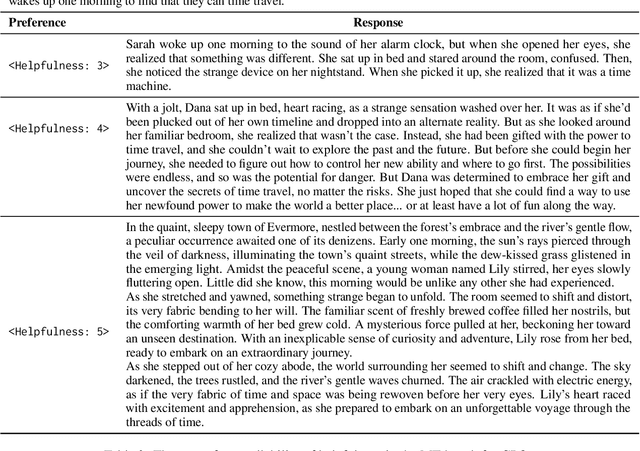
Abstract:Alignment in artificial intelligence pursues the consistency between model responses and human preferences as well as values. In practice, the multifaceted nature of human preferences inadvertently introduces what is known as the "alignment tax" -a compromise where enhancements in alignment within one objective (e.g.,harmlessness) can diminish performance in others (e.g.,helpfulness). However, existing alignment techniques are mostly unidirectional, leading to suboptimal trade-offs and poor flexibility over various objectives. To navigate this challenge, we argue the prominence of grounding LLMs with evident preferences. We introduce controllable preference optimization (CPO), which explicitly specifies preference scores for different objectives, thereby guiding the model to generate responses that meet the requirements. Our experimental analysis reveals that the aligned models can provide responses that match various preferences among the "3H" (helpfulness, honesty, harmlessness) desiderata. Furthermore, by introducing diverse data and alignment goals, we surpass baseline methods in aligning with single objectives, hence mitigating the impact of the alignment tax and achieving Pareto improvements in multi-objective alignment.
Executable Code Actions Elicit Better LLM Agents
Feb 01, 2024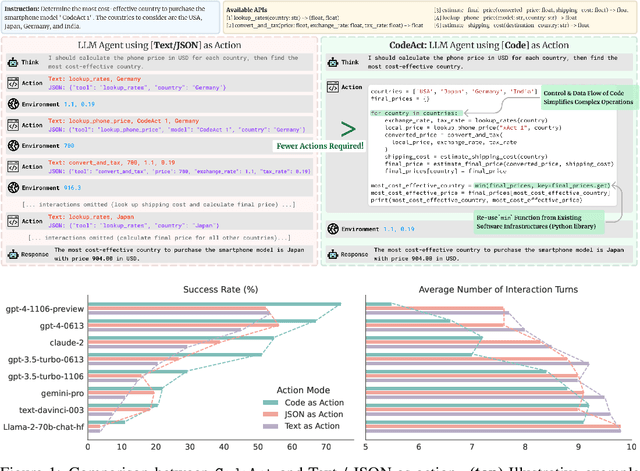

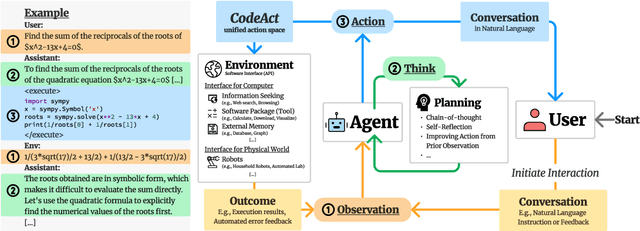
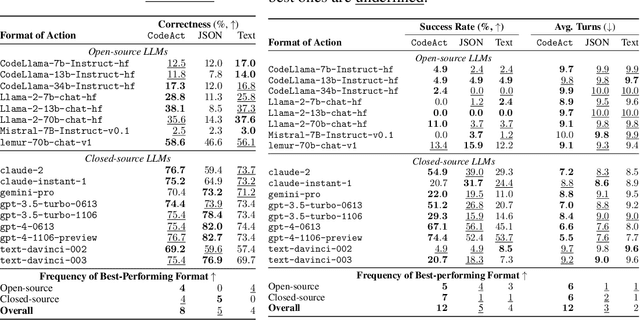
Abstract:Large Language Model (LLM) agents, capable of performing a broad range of actions, such as invoking tools and controlling robots, show great potential in tackling real-world challenges. LLM agents are typically prompted to produce actions by generating JSON or text in a pre-defined format, which is usually limited by constrained action space (e.g., the scope of pre-defined tools) and restricted flexibility (e.g., inability to compose multiple tools). This work proposes to use executable Python code to consolidate LLM agents' actions into a unified action space (CodeAct). Integrated with a Python interpreter, CodeAct can execute code actions and dynamically revise prior actions or emit new actions upon new observations through multi-turn interactions. Our extensive analysis of 17 LLMs on API-Bank and a newly curated benchmark shows that CodeAct outperforms widely used alternatives (up to 20% higher success rate). The encouraging performance of CodeAct motivates us to build an open-source LLM agent that interacts with environments by executing interpretable code and collaborates with users using natural language. To this end, we collect an instruction-tuning dataset CodeActInstruct that consists of 7k multi-turn interactions using CodeAct. We show that it can be used with existing data to improve models in agent-oriented tasks without compromising their general capability. CodeActAgent, finetuned from Llama2 and Mistral, is integrated with Python interpreter and uniquely tailored to perform sophisticated tasks (e.g., model training) using existing libraries and autonomously self-debug.
 Add to Chrome
Add to Chrome Add to Firefox
Add to Firefox Add to Edge
Add to Edge